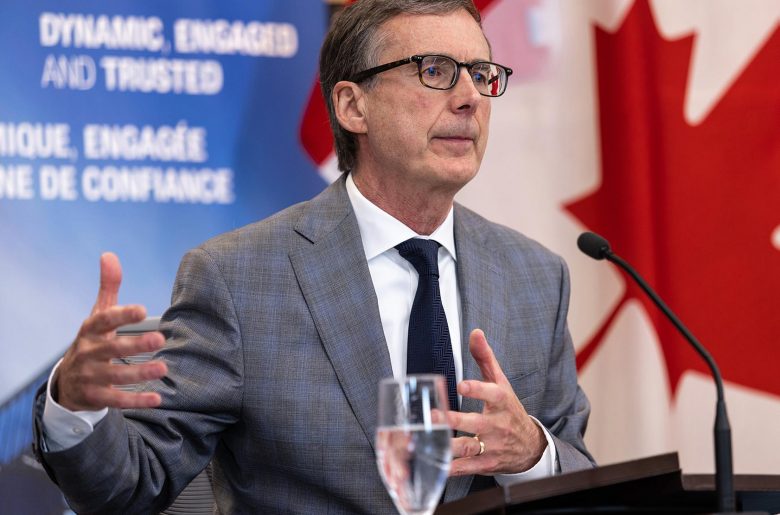
Governor’s foreword
Last year was tough for Canadians and challenging for the Bank of Canada.
Inflation started the year at just under 5% and rose to 8% in June, before falling to just over 6% by the end of the year. Canadians experienced the hardship of high inflation, finding it increasingly difficult to stretch their paycheques and cover their bills. Lower-income Canadians were especially hard hit because the prices of many essentials—such as food and rent—rose sharply.
Understandably, Canadians had many questions for the Bank of Canada. Why is inflation so high? What is the Bank doing about it? And when will inflation come down? Let me address each of these in turn.
At the start of 2022, inflation was already elevated. This largely reflected widespread and persistent supply chain disruptions amid strong global demand for goods. Then in February, Russia’s unprovoked invasion of Ukraine caused global prices of oil and other commodities to rise sharply, pushing inflation even higher. And from there, inflation broadened and intensified. This reflected the pass-through of higher energy, food and shipping costs to many goods and services prices. It also reflected rising price pressures domestically. When the Canadian economy fully reopened, consumers wanted to catch up on what they had missed, but businesses couldn’t keep up with the increased demand. This put upward pressure on the prices of many services.
The Bank was—and remains—resolute in its commitment to return inflation to the 2% target. To bring inflation back down, we raised the policy interest rate through seven consecutive monetary policy decisions in 2022, taking it from a COVID‑19 pandemic–related low of 0.25% all the way to 4.25%. In April, we also began quantitative tightening, the process of shrinking the Bank’s balance sheet.
Because inflation rose quickly, we moved interest rates up forcefully. History tells us this approach gives us the best chance of avoiding the need for even larger increases later and, potentially, a severe recession—something no one wants.
By the end of 2022, inflation was still too high, but it had started to decline. This mainly reflected lower energy prices and the easing of global supply chain bottlenecks. More restrictive monetary policy had also started to reduce spending, especially in parts of the economy that are sensitive to interest rates, such as housing and furniture sales.
As we move through 2023, we anticipate the effects of higher interest rates will continue to spread through the economy, slowing spending further and letting supply catch up to demand. This should relieve price pressures more broadly and bring inflation down substantially over the course of the year.
The large climb in inflation through the first half of 2022 surprised us. The misses in our forecasts led to an intensification of work to better understand inflationary pressures and the appropriate responses to them during times of global upheaval and supply constraints. Three lessons stand out:
- Increasing the supply of goods and services is harder than restoring demand. Our monetary policy tools were very effective in supporting demand through the pandemic, but we underestimated the persistence of supply disruptions.
- The overall gap between demand and supply in the economy doesn’t tell the whole story. During lockdowns, higher demand for goods did more to push prices up than lower demand for services did to pull them down.
- The inflationary consequences of supply disruptions are more acute when the economy is overheated. That’s because businesses aren’t as worried that they will lose sales if they raise prices.
We know that the adjustment to higher interest rates has been hard for many households—particularly those with significant debt loads. And we also know that, for many, it can be counterintuitive that raising borrowing costs when other costs are already rising will reduce inflation. But by the end of 2022, we could see tighter monetary policy beginning to help rebalance the economy and reduce inflationary pressures. We ended the year a long way from our 2% inflation target, but we are confident that monetary policy is working to restore price stability.
Also in 2022, the Bank incurred a net loss for the first time. Following a period of above-average income associated with quantitative easing in 2020 and 2021, the Bank incurred a net interest expense in 2022. We expect to continue to incur such losses for a couple of years before returning to a positive net income position. The size and duration of the losses will depend on a number of factors, including the path of interest rates and the evolution of both the economy and our balance sheet.
The Minister of Finance has indicated that the government plans to introduce legislative amendments to allow the Bank to temporarily retain its net income in the future instead of remitting it to the Government of Canada. This would give the Bank the ability to offset net losses with future net income. Once sufficient positive equity is restored, the Bank would resume remitting to the government. I want to stress that we do not conduct monetary policy with a profit motive. Our policy decisions are driven by our price and financial stability mandates.
Throughout 2022, we maintained our commitment to transparency and promoted public understanding through proactive communications, outreach and engagement. We welcomed tough questions, and we were transparent about what we got right and what we didn’t. We explained our decisions and thinking in press conferences, speeches and media interviews. We also stepped up our efforts to engage with Canadians through effective use of social media and the reopening of the Bank of Canada Museum.
Beyond the immediate challenges of the pandemic and high inflation, we continued our focus on operational resilience and completing major business transformations—such as reinforcing our ability to recover from disruptions and enhancing our cyber security controls.
We also expanded our tool kit for understanding economic and financial system risks associated with climate change. We published results of a pilot project—undertaken with the Office of the Superintendent of Financial Institutions and several major financial institutions—to assess how the economy and financial system may be affected by different transition scenarios to a lower-carbon economy.
We enhanced our global influence in several critical areas. These include the evaluation of the Basel III banking reforms, the future of the international monetary system, and the development of global best practices for regulating crypto assets.
Here in Canada, we promoted the stability and security of a rapidly evolving landscape for payment systems and methods.
- We continued our work related to the new mandate that we took on in 2021 for retail payments supervision in Canada.
- We expanded our engagement with industry to fully understand the breadth and interconnectedness of the retail payments ecosystem.
- We also provided advice to the Department of Finance Canada as it developed regulations.
Throughout the year, the Bank focused on supporting our employees in their return to onsite work after more than two years away from the office. We launched a hybrid work model and made sure our physical and online spaces were ready.
Our leaders and staff continued to display integrity, professionalism and a tireless work ethic. They were supported in their work by an updated strategy to support equity, diversity and inclusion, and we created an accessibility plan in collaboration with stakeholders from across the Bank. So I am delighted that we were named one of Canada’s Top 100 Employers for the 13th consecutive year as well as one of Canada’s Top Family-Friendly Employers and Best Diversity Employers.
As for our top job—controlling inflation—Canadians can count on us to get it done. High inflation has been painful for everyone, but our forceful response in 2022 is working. Demand is slowing, allowing supply to catch up, and inflation is coming down. We are determined to restore price stability so that Canadians can once again enjoy low, stable and predictable inflation and sustainable economic growth.
On behalf of the Bank’s Board of Directors and staff, I pledge the Bank’s continued service to Canadians as we face new challenges in the year ahead. No matter what 2023 brings, we will continue to promote the economic and financial well-being of Canadians from coast to coast to coast.
Tiff Macklem
Governor

